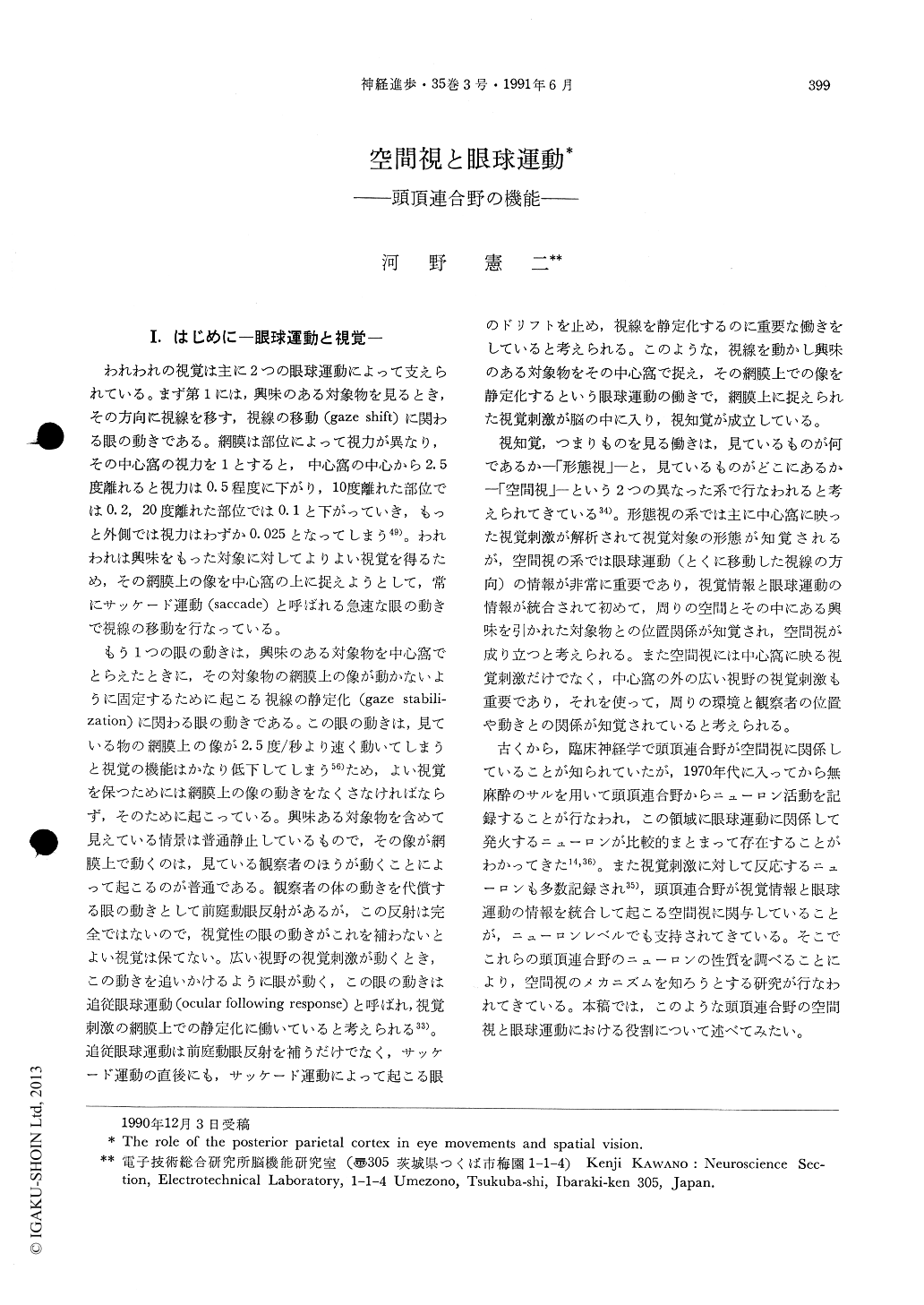Japanese
English
- 有料閲覧
- Abstract 文献概要
- 1ページ目 Look Inside
I.はじめに―眼球運動と視覚―
われわれの視覚は主に2つの眼球運動によって支えられている。まず第1には,興味のある対象物を見るとき,その方向に視線を移す,視線の移動(gaze shift)に関わる眼の動きである。網膜は部位によって視力が異なり,その中心窩の視力を1とすると,中心窩の中心から2.5度離れると視力は0.5程度に下がり,10度離れた部位では0.2,20度離れた部位では0.1と下がっていき,もっと外側では視力はわずか0.025となってしまう49)。われわれは興味をもった対象に対してよりよい視覚を得るため,その網膜上の像を中心窩の上に捉えようとして,常にサッケード運動(saccade)と呼ばれる急速な眼の動きで視線の移動を行なっている。
もう1つの眼の動きは,興味のある対象物を中心窩でとらえたときに,その対象物の網膜上の像が動かないように固定するために起こる視線の静定化(gaze stabilization)に関わる眼の動きである。この眼の動きは,見ている物の網膜上の像が2.5度/秒より速く動いてしまうと視覚の機能はかなり低下してしまう56)ため,よい視覚を保つためには網膜上の像の動きをなくさなければならず,そのために起こっている。興味ある対象物を含めて見えている情景は普通静止しているもので,その像が網膜上で動くのは,見ている観察者のほうが動くことによって起こるのが普通である。
It has been known in clinical studies that lesions of the parietooccipital cortex cause disturbances of ocular motility and spatial perception (Holmes, 1918). Using behaving awake monkeys, electrophysiological studies revealed that there are neurons whose activities are related to visually guided eye movements and/or spatial vision in the posterior parietal cortex (Hyvarinen, 1974; Mountcastle, et al., 1975). Neurons whose activities are related to eye movements are classified into three groups (Lynch, et al., 1977): 1) Visual fixation neurons, 2) Visual tracking neurons, 3) Saccade neurons. Visual fixation neurons are continuously active when a monkey fixes its gaze on a visual target in an appropriate position. Most of the visual fixation neurons had a preferred direction of gaze along the horizontal, vertical or diagonal axis (Sakata, et al., 1980). In general, the discharge rate of the visual fixation neurons was a monotonic increasing function of the angle of deviation of the gaze from the center in a preferred direction. Visual tracking neurons discharge when the animal smoothly pursues with its eyes an object moving in a particular preferred direction, but not in relation to static visual fixation (Lynch, et al., 1977). Saccade neurons are active when the animal makes saccades to follow a jump of a fixation target, but are not active when the animal makes spontaneous saccades (Lynch, et al., 1977). Further studies of these oculomotor-related neurons showed that most of them responded to visual stimulation. On the ohter hand, there are evidences that some of the oculomotor-related neurons can be activated without visual stimulation, suggesting the existence of extraretinal inputs that affect their activities (Andersen, et al., 1985; Sakata, et al., 1980, 1983). These results suggest that the oculomotor-related neurons in the posterior parietal cortex may be situated in the process of sensorimotor integration and have roles in internal reconstruction of the object's motion and position in space. The internally reconstructed motion and position of the object in space might have a role not only in visual spatial perception but also in elucidating a next eye movement. Light sensitivve neurons whose firing rates were modulated by the angle of gaze were also found in the posterior parietal cortex (Andersen, et al., 1985). They are also likely to integrate eye movement information and visual information and to construct an internal representation of the object in space.

Copyright © 1991, Igaku-Shoin Ltd. All rights reserved.


